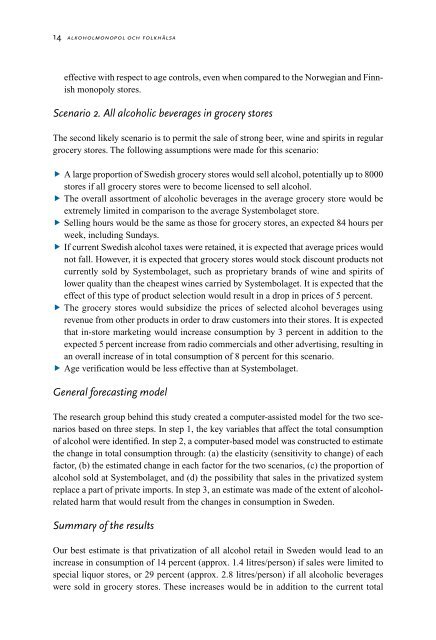Alkoholmonopol och folkhälsa - Statens folkhälsoinstitut
Alkoholmonopol och folkhälsa - Statens folkhälsoinstitut
Alkoholmonopol och folkhälsa - Statens folkhälsoinstitut
You also want an ePaper? Increase the reach of your titles
YUMPU automatically turns print PDFs into web optimized ePapers that Google loves.
14 alkoholmonopol <strong>och</strong> <strong>folkhälsa</strong><br />
effective with respect to age controls, even when compared to the Norwegian and Finnish<br />
monopoly stores.<br />
Scenario 2. All alcoholic beverages in grocery stores<br />
The second likely scenario is to permit the sale of strong beer, wine and spirits in regular<br />
grocery stores. The following assumptions were made for this scenario:<br />
A large proportion of Swedish grocery stores would sell alcohol, potentially up to 8000<br />
stores if all grocery stores were to become licensed to sell alcohol.<br />
The overall assortment of alcoholic beverages in the average grocery store would be<br />
extremely limited in comparison to the average Systembolaget store.<br />
Selling hours would be the same as those for grocery stores, an expected 84 hours per<br />
week, including Sundays.<br />
If current Swedish alcohol taxes were retained, it is expected that average prices would<br />
not fall. However, it is expected that grocery stores would stock discount products not<br />
currently sold by Systembolaget, such as proprietary brands of wine and spirits of<br />
lower quality than the cheapest wines carried by Systembolaget. It is expected that the<br />
effect of this type of product selection would result in a drop in prices of 5 percent.<br />
The grocery stores would subsidize the prices of selected alcohol beverages using<br />
revenue from other products in order to draw customers into their stores. It is expected<br />
that in-store marketing would increase consumption by 3 percent in addition to the<br />
expected 5 percent increase from radio commercials and other advertising, resulting in<br />
an overall increase of in total consumption of 8 percent for this scenario.<br />
Age verification would be less effective than at Systembolaget.<br />
General forecasting model<br />
The research group behind this study created a computer-assisted model for the two scenarios<br />
based on three steps. In step 1, the key variables that affect the total consumption<br />
of alcohol were identified. In step 2, a computer-based model was constructed to estimate<br />
the change in total consumption through: (a) the elasticity (sensitivity to change) of each<br />
factor, (b) the estimated change in each factor for the two scenarios, (c) the proportion of<br />
alcohol sold at Systembolaget, and (d) the possibility that sales in the privatized system<br />
replace a part of private imports. In step 3, an estimate was made of the extent of alcoholrelated<br />
harm that would result from the changes in consumption in Sweden.<br />
Summary of the results<br />
Our best estimate is that privatization of all alcohol retail in Sweden would lead to an<br />
increase in consumption of 14 percent (approx. 1.4 litres/person) if sales were limited to<br />
special liquor stores, or 29 percent (approx. 2.8 litres/person) if all alcoholic beverages<br />
were sold in grocery stores. These increases would be in addition to the current total
















